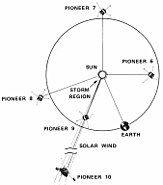Pioneer 7
| Pioneer 7 | |||||||||||||
|---|---|---|---|---|---|---|---|---|---|---|---|---|---|
 Artist's impression of Pioneer 7 |
|||||||||||||
| NSSDC ID | 1966-075A | ||||||||||||
| Mission goal | Investigation of interplanetary space | ||||||||||||
| Client |
|
||||||||||||
| Launcher | Delta-E | ||||||||||||
| construction | |||||||||||||
| Takeoff mass | 138 kg | ||||||||||||
| Course of the mission | |||||||||||||
| Start date | August 17, 1966, 3:20 pm UTC | ||||||||||||
| launch pad | CCAFS , LC-17 | ||||||||||||
| End date | March 31, 1995 | ||||||||||||
|
|||||||||||||
Pioneer 7 was a space probe from the US space agency NASA as part of the Pioneer program. It was the second of four successful and one failed Pioneer probes to measure solar activity and its impact on interplanetary space. Like the Pioneer 6 and the planned subsequent probes, it should take measurements in a heliocentric orbit and warn of solar storms , among other things .
construction
Pioneer 7 had a cylindrical body with a height of 81 centimeters and a diameter of 94 centimeters. In addition to an internal battery, the probe was covered with a total of 10,368 solar cells on its body to ensure the power supply. The probe was twist stabilized and had several nozzles operated with nitrogen. In addition, two rods aligned with the interplanetary magnetic field provided the necessary stability. There were a total of ten different instruments on board, including a magnetometer , an instrument for measuring the solar wind and a telescope for measuring the cosmic background radiation .
mission
After launch, Pioneer 7 was placed in a heliocentric orbit between Earth and Mars . A rotation of 60 revolutions per minute around the longitudinal axis of the probe ensured spin stabilization . The measurement results were temporarily stored on a tape drive and then transferred to the ground station. Since the probe flew out of orbit, it was able to examine the magnetic tail of the earth on September 7, 1968. On March 20, 1986, Pioneer 7 passed Comet Halley at a distance of approximately 12.3 million kilometers and examined the interaction between hydrogen exiting the comet and the solar wind. Like its predecessor, the Pioneer 7 was only designed for an operating time of 6 months, but provided data for much longer.
Results
The mission was a complete success. Pioneer 7 was designed for a lifespan of around 6 months, which it far exceeded. It also provided data on solar storms that were used by more than 1,000 institutions and companies. Unlike Pioneer 6, there is no intention to contact the probe again.
Web links and sources
- Pioneer 7 at NASA: Solar System Exploration (English)
- Description of the Pioneer 7 mission in the NSSDC (English)
- Bernd Leitenberger: The Pioneer Program

